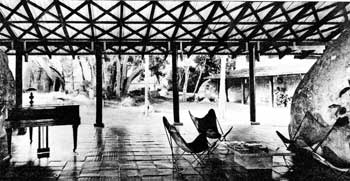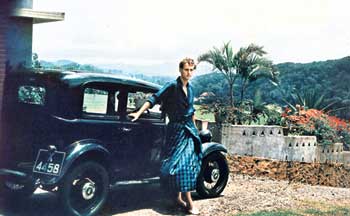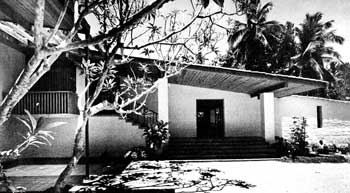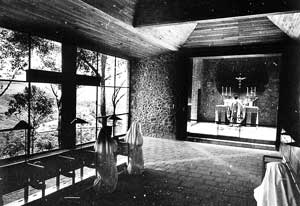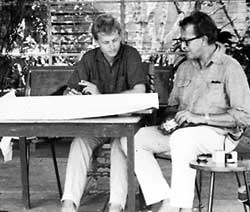
If there was Bawa there was PlesnerArchitect Ulrik Plesner, long associated with Sri Lanka’s most famous architect Geoffrey Bawa will be honoured by the Sri Lanka Institute of Architects at their annual sessions this week.
That’s too far back! I grew up with three languages: I was born in Italy in 1930; my mother was English and my father who died when I was young was Danish. My stepfather was a well-known architect who built Copenhagen Cathedral. He took me with him to site, and my earliest memories are of climbing scaffolding up around the domes. After the war I went to the Royal Academy in Copenhagen. It was all based on craft – half the students were carpenters and bricklayers, the other half just passed out of high school. So you got a mix of craftsmen and academics, very fruitful.
Maybe… I am not advocating a return but I am advocating that architects should have their feet in reality. They have just become like fashion designers. It’s a style thing. Somebody else has to make it work.
One of the things in Denmark was that all public work went to competition. All schools, churches, libraries - anything that was a public building and most public housing - went to competition. That was how all young architects got established. That's how they got work. In 1957 there were two international competitions. One was the Sydney Opera House competition and the other a competition for a Buddha monument in New Delhi where Nehru was head of the judging committee. I participated in the Buddha memorial competition and got second prize and it made my life, because I did not have to spend years building it and delivering it. I got an invitation to India to collect the prize. An ex-girl friend of mine who was a photographer on the movie “Bridge on the River Kwai” and who had met Minette (de Silva), asked me to come out. Minette was 30 something and I was 27. Minette met me in her little Ford Anglia and we drove all the way back to Kandy. Minette was having an affair at the time with David Lean, the director of the movie. Within a couple of days I was in love with everything. I was in love with Kandy, I was in love with Minette. And I never went out of love. It was the happiest period of my life! I was staying in her brother Fred de Silva’s house in Kandy which is now Helga’s Folly. When Minette didn’t pay me her brother fed me and I did not pay any rent. I was interested in historical architecture and I had taken summer courses in measuring old buildings. I had all the techniques and equipment and I fell in love with all the old buildings like Embekke and Lankatillake, and old Walauwas. There was a famous American architecture photographer who said “ah, you are going to Minette de Silva. She is the only progressive architect in Asia”. At that time everything in India, Sri Lanka, Singapore, Hong Kong was all British PWD, small windows, or like the Colombo Municipality: Grand European architecture with big columns and pretentious stuff with domes and all that which had no place in Sri Lanka. The real colonial stuff was built by engineers in the 19th Century who knew the climate and tried to build with verandahs and big roofs and who learnt from existing conditions and respected them.
At the same time I fell in love with all the traditional stuff because it was so obviously right for the climate and right for the ability of the existing craftsmen. The village baases knew how to build like this and could do it; and you got through ventilation; and you protected against the rain and the sun and all that. And then Minette got all excited about that too, so I think I infected her. I was a great enthusiast when I was young. Now I am more cynical! Then one day, there was a party in a tea estate in Kadugannawa, and I ran into Geoffrey Bawa. We hit it off immediately. It was fantastic. To me he remains the greatest person I have met in my life. A great man with great faults. The truth is we had a fantastic relationship for the next nine years. We both were unmarried. We had servants and drivers and we were totally selfish, we only had ourselves to think about. No shopping, no cooking, no wives, no children. Nothing to divert us. I think in those nine years we built more than many architects build in their whole life.
Many of the buildings have disappeared or changed out of recognition. I joined Edward Reid and Begg freelance in December 58. I rented a room outside of Colombo in an old walauwa. They gave me jobs, a house for this and a house for that and I came in once a day and showed it to Jimmy Nilgiria or Geoffrey or whoever was in charge of that job. I think the house for N.U. Jayawardene started like that, on Cambridge Place. It was a flat roof modernistic house and I put all my heart and soul into it. It was the time that you could still import things from abroad, the best sliding gear, the best toilets. It was not Sri Lankan at all. At the same time Geoffrey did the AA building, an equally foreign building, and we were both equally dissatisfied. These buildings had nothing to do with the surrounding, the environment, the climate. They needed air conditioning. So that was the year we were both searching around. Le Corbusier's hot concrete boxes in India were not an acceptable guide. Buildings have their own fate just like people. They have their own Karma and I don’t believe the architect or client has any right over it. You just hope they will fall in love with it and keep it. Some do, some don’t. Edward Reid and Begg became the architects for all the great foreign companies - Lever Brothers, Ceylon Trading, the Banks and all that. There weren’t that many other architects, only about 20, 10 in the PWD and 10 private. All were Ceylonese. I was the only non-Ceylonese. At this time I discovered Donald Friend. He was a friend of Bevis Bawa. They’d met on a ship. He came to stay a week and stayed five years. He was a great original, now considered one of the great artists in Australia. He was wonderful and I got Bauers to commission a mural from him at the entrance to Bauers. Later when I did McKinnon and McKenzies (now the John Keels office) I got him to do big murals inside. The Shell Co. came in and they wanted a standard Bungalow for their manager in Anuradhapura. This was a key building in my life. It was just a simple house, a standard bungalow of the kind Edwards Reid and Begg produced by the minute. I did another house which was a long house where all the rooms had two sides with a verandah of 10 foot eaves all around – the verandah was bigger then the house - and a big tiled roof that ended with ventilation at the hips with louvers set back in. The ceiling was flat and the whole roof space was ventilated from these openings. This was built by Tudawe in six months and every now and then Tudawe and I went together there by train to Anuradhapuraand supervised it and it came out beautifully. And then one day I took Geoffrey up when it was finished and we both said “It’s all in the roof! The roof is the answer to architecture in this climate, in this place in this context”
From then on we had no doubts. We both went straight forward and everything we did was a combination of roofs and open-ness. Driving back in his Rolls from Anuradhapura we just looked at all the old buildings along the road all with roofs and columns andverandah and open landscape in between. This must have been the end of 1959. I have to say something in general about Geoffrey and me. We worked together as I told you. At breakfast we met, we met at lunch, we met at dinner. In the evenings we sat together and every weekend we went together to Bentota and worked. In the office we separated and Geoffrey looked after whatever job he was in charge of and I looked after whatever job I was in charge of. So technically we were separated but architecturally it was totally inseparable and we agreed later when we published that it should all published together as Geoffrey Bawa and Ulrik Plesner. You couldn’t say Edward Reid and Begg, because ERB had no place. We were a new combination within the business of ERB and it was only after I left that the question arose. The next significant job was Ena De Silva’s house. We worked that out together. It has seven different courtyards. One big one in the middle, and small courtyards all around. And the whole business of bedrooms upstairs where you can sleep on the window sills, it was the length and width of a bed with a trellis outside so you have privacy and you don’t fall out while you slept. Of course Ena was a great client because she fell in love with the whole idea herself. She fell in love with everything that Geoffrey said from the first moment. That was the first house where the whole thing came to fruition. The whole concept of the big roof. About protection from the rain and sun and nothing else and letting the air go through. She had all these carpenters and skills up on the estate in Aluvihare and we got huge satinwood columns that she fetched from the jungle. It was kind of a whole mutual inspiration society, between Ena and him and me. At the end when we separated for basically political reasons we decided for practical purposes to split the credit for jobs so we did not claim the same things.
David Robson has not accepted our split, so he's been allocating all the things that I did to Geoffrey. Basically I was the teacher and Geoffrey the artist. Geoffrey saw architecture as an extension of landscaping by other means. He wasn’t interested in kitchens or toilets or foundations or any of that, but had a fantastic sense of space and planting and a very sure visual talent. We saw things the same way, we agreed on everything but I was the one who provided the practical foundation, the one who knew how it was done. How to make a door, how to make a window, how to make a roof, how to make the tree stand up. That’s why I said we went hand in hand like that. Later on when we separated we both missed the other half. None of the work we did subsequently, neither his nor mine, was as good as what we did together.
I can’t say. It's inextricable, and we agreed that that was the case. In the same way, Geoffrey is an inextricable part of the Polawantalawa house which was basically mine. It was only when I left and somebody made a book about him, the white Mimar book, that Geoffrey became the Hero and I disappeared. It's like the battlefield. The one who stays in the battlefield is the winner, the one who secedes the battlefield is the looser. So Geoffrey became the Hero and that’s how it goes. If you want to know how it happened. That’s how it happened!
Everything we did between 1957 and 1967. St. Bridget’s and St. Thomas’s Prep. I was involved in the beginning of the Bentota hotel. That was done while I was in London looking after the Hilton. The Hilton, we also did together though I was the partner who went to London to look after it. It was not built.
That was much later. I was called back because as it happened JR and Alwis and Gamini were all my old buddies from the sixties. Suddenly my buddies were the government and they asked me to come back.
Because they were all nobodies like us. They were all friends of Geoffrey, all part of the same 50 or 100 families.
The minister of finance was N.M. Perera and the other was Colvin R. De Silva. They were becoming more and more Trotskyite and there were import regulations and the clients were now becoming Russians. I was doing the new East German television station and Geoffrey was doing Aurovilla for Russian Aid and it was more and more becoming the government of a communist country. We thought Sri Lanka would go the way of Vietnam and I thought I was not born here, I would be the first to get a kick in the ass, better start somewhere else whilst I was still young enough. Geoffrey was very offended and got very angry that I left. So from then on, he sort of cut all recognition and all that.
He wasn’t that kind of person. He never argued. In all those nine years we never argued. We always agreed about everything, almost without talking. In the beginning I lived at Bauers flats before I built my annexe at Barbara Sansoni’s house. Barbara and her husband came in and they wanted to build a little annex for renting. So we sat and we got such immediate chemistry, so I said “great I’ll design it and live in it and rent it from you”. They said immediately “fine”. “We won’t charge you any rent” so I said “we won’t charge you any fee”. So within a minute we had settled all that and they went for a year to America and I designed and built the house while they were in America. And they came back and we remained best friends ever since. That was also just a landscape within a roof with an open-ness. Only three doors: toilet door, kitchen door and front door. The rest was all open, to the garden and everywhere. That house has been published. And Morris and Malkanthi Perera’s house and Ian and Gun Pieris’s house in Barnes Place. We also did the Girls town in Piliyandala and another Girls town Farm school in Hanwella, Yahapath Endera and the Boys town in South India Madurai. I was looking after it. I refused to distinguish between what he did and what I did.
You were going to tell us about Geoffrey being a great man who also had great faults. He was a great man. He had an incredible sense of humour and could say something in just a sentence or two that would absolutely hit the nail on the head and was extremely amusing at the same time. When I went to bed in the evening I usually had a sore stomach from laughing. And not only me but all his baas’s giggled; He never stuck to the drawings; if he saw something he didn’t like, he pulled it down and did it again. But all the baas’s loved him because he was always making them laugh, in Sinhalese. They were surprised that he spoke such good Sinhalese. He was brought up with Sinhalese in the house. So for him it was – I don’t know if it was a first language – but it certainly was not a second language. There was Sabdeen baas who did Bentota and many of the houses and I think he built Ena’s house. He was Geoffrey’s slave. He loved everything. He said, “Pull it down” he pulled it down, he said “build it” he built it, “pull it down again”, he pulled it down. He loved the whole process. When Geoffrey brought back a Rolls from England (he was a bit of a snob) Bevis got so jealous; he knew that old Mr. Davidson had a Rolls Royce standing in the garden so he went there and made friends with Mr. Davidson and finally offered some money. He emptied the car of earth. This Rolls was the first car that had an aluminum engine, it wasn’t rusted, so he turned the key, and off it went. These are the kind of stories that Geoffrey could tell endlessly. About growing up in the rubber estates in Negombo, and all the family stories. And whenever I could check with relatives, they were always true. He was never nasty. He was never wicked. He could be selfish. He was incredibly selfish. Self centered like that. And I think that was one of the things that started the end.
That’s right. And by 80 when the Mahaweli was going they asked me to come with Naveen Gunaratne. But there was no room for two; it was one big planning job. I started the whole Mahaweli Architectural Unit under the Irrigation Department or something like that. The Chief architect was an Irrigation Engineer, the planners were in the UDA, they didn’t have time. They were planning new towns in jungles where they had never been. The cost was tremendous. It would have been a desert of roads. So I said to Gamini that it had to be like the parliament, where in the end Geoffrey went to JR and said if he didn’t make him solely responsible it would never happen. The PWD was constantly having meetings and tripping him up. So I went to Gamini and said “If the Parliament had been run like we are running the Mahaweli, the foundations would never even have been laid”. So he took it away from the Irrigation Department and set up n architectural unit responsible directly to him. That was theMAU (Mahaweli Architectural Unit) and I was head of it. My policy was to employ only Sri Lankans and not foreigners, and my job was to make myself superfluous: after seven or eight years I retired and passed it on to a Lankan.
Oh yes, over his whole life. We wrote long letters. He wrote fabulous letters. He was like Oscar Wilde. He had this ability to formulate things in an acutely amusing way and describe things dead on.
I thought my job had come to an end. I had created an office up there; we got an old tea factory near Teldeniya. And we were about 50 people including about 10 drivers, 10 jeeps and 30 young architects. Most of the architects – there were two senior Lanka architects – and all others were almost students because very few senior architects in Colombo wanted to come, partly because the pay was poor, partly because it was far away and their children wanted to go to English speaking schools. This business of foreign aid was an unpleasant one. You got all these foreign experts paid huge amounts, a thousand dollars a month, and their family were brought out; the Ceylonese architects were paid by the Mahaweli organization and had to follow the ministry's pay scale. So you got people of equal training and talent earning ten times less. It was a kind of humiliation for them. They didn’t like it and I understood that. When I left in 67 I had gone to London because I was doing the Hilton – the unbuilt Hilton. While there I worked for Ove Arup with Mr. Arup himself, and then I went to Israel with my Israeli wife and became City architect of Jerusalem. I found I was not built to be a civil servant and resigned after two years. I started my own office and did houses, sports centers, schools and community centers. It's difficult when you start in a new country: you don’t know anybody, you don’t have a framework, you don’t have old buddies you went to school with, you are an unknown character. It took me some years to get in, but these last fifteen years we have been very much in. The office is thriving. I am now based in Israel. I decided we either have to live in my wife’s country or my country. The weather is much better in Israel than in Denmark, so I decided to go to Israel. I have not regretted it although the politics is horrible! My daughters have their practice in Israel together with me. |
|
||||||
|| Front
Page | News | Editorial | Columns | Sports | Plus | Financial
Times | International | Mirror | TV
Times | Funday
Times || |
| |
Reproduction of articles permitted when used without any alterations to contents and the source. |
© Copyright
2008 | Wijeya
Newspapers Ltd.Colombo. Sri Lanka. All Rights Reserved. |
